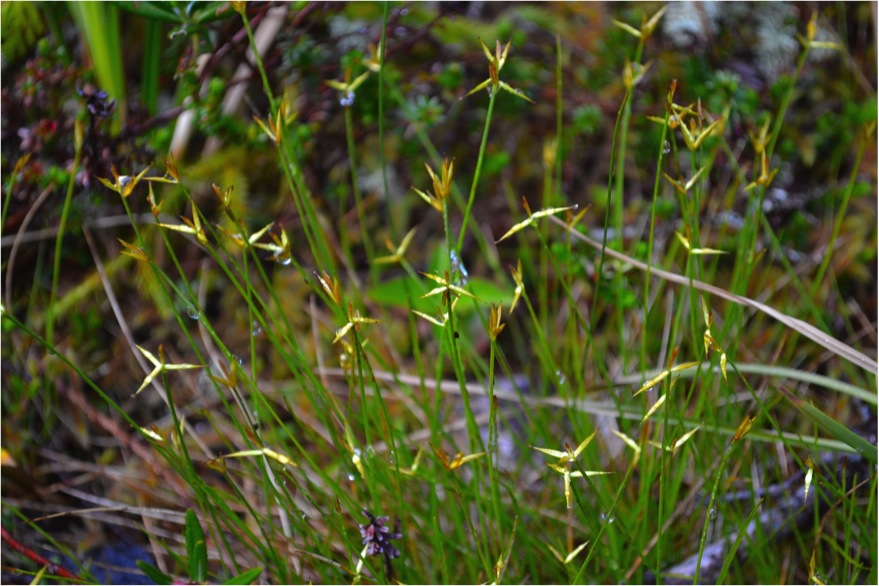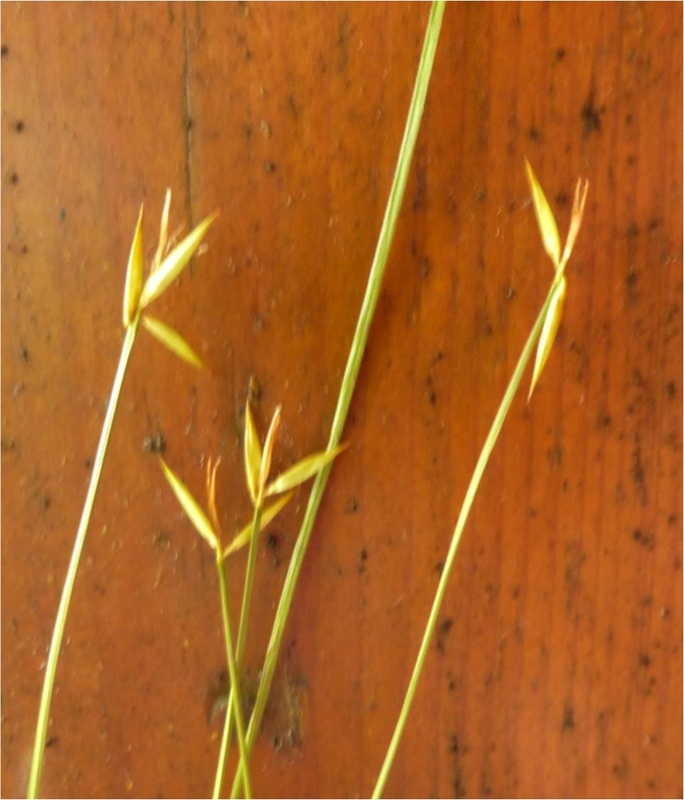Few-flowered sedge • Carex pauciflora
{pauciflora = few-flowered}
Few-flowered sedge. Photos by Christian Kelly (left) and Laura Kroesen. In these photos some of the perigynia are bent backwards, which happens at maturity, and which gives a splayed, windmill-like appearance.
Identification
Few-flowered sedge is a perennial species with single stems arising alone or in small groups. The stems are stiff, brownish, grow to 40 cm tall, and are curved at the base. The 1-3 leaves are thin (at most 1.5 mm wide), channeled, pointed, and have tight brownish sheaths. Each stem bears a single bract-less spike. These spikes have a few thin 6-8 mm long perigynia; they are greenish-brown and have light brown scales. When mature the perigynia bend back and downwards; this creates a splayed, windmill-like structure at the top of each stem.
Click here for a more detailed description and some useful diagrams.
Habitat & Range
This is a scattered but relatively common species in bogs and fens from low to middle elevations. It is a common species in coastal and east-central BC, and occurs infrequently in other areas. Its range stretches across much of northern North America and Eurasia.
Similar Species
The long, backwards- and downwards-bent perigynia are indicative of this species.
Few-flowered sedge is a perennial species with single stems arising alone or in small groups. The stems are stiff, brownish, grow to 40 cm tall, and are curved at the base. The 1-3 leaves are thin (at most 1.5 mm wide), channeled, pointed, and have tight brownish sheaths. Each stem bears a single bract-less spike. These spikes have a few thin 6-8 mm long perigynia; they are greenish-brown and have light brown scales. When mature the perigynia bend back and downwards; this creates a splayed, windmill-like structure at the top of each stem.
Click here for a more detailed description and some useful diagrams.
Habitat & Range
This is a scattered but relatively common species in bogs and fens from low to middle elevations. It is a common species in coastal and east-central BC, and occurs infrequently in other areas. Its range stretches across much of northern North America and Eurasia.
Similar Species
The long, backwards- and downwards-bent perigynia are indicative of this species.
References
Carex pauciflora Lightf. In Klinkenberg, Brian. (Ed.). E-Flora BC: ElectronicAtlas of the Plants of British Columbia. Lab for Advanced Spatial Analysis, Department of Geography, University of British Columbia, Vancouver. Accessed 11/09/2013.
Pojar, J. and MacKinnon, A. (1994). Plants of Coastal British Columbia. Vancouver, BC: Lone Pine Publishing. P. 392.
Authors and editors of page
Kelly Fretwell and Brian Starzomski (2013).
Carex pauciflora Lightf. In Klinkenberg, Brian. (Ed.). E-Flora BC: ElectronicAtlas of the Plants of British Columbia. Lab for Advanced Spatial Analysis, Department of Geography, University of British Columbia, Vancouver. Accessed 11/09/2013.
Pojar, J. and MacKinnon, A. (1994). Plants of Coastal British Columbia. Vancouver, BC: Lone Pine Publishing. P. 392.
Authors and editors of page
Kelly Fretwell and Brian Starzomski (2013).





